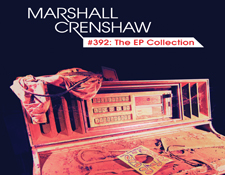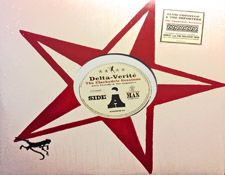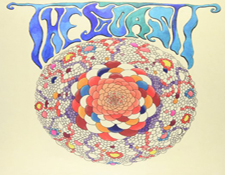It’s the time of year for saving money!
I’ve talked about EPs — or Extended Play mini albums, if you will — a bit here in the past so I won’t muddy up my review with loads of babble about the format, benefits and such. But I will say that if you are into certain types of music and artists who are fairly prolific, keep an eye out for these oft-fleeting releases which typically are put out as a stop-gap between album releases. Or sometimes they are put out simply for the fun of it…. Here are some EPs I’ve been exploring from :
 MARSHALL CRENSHAW : No stranger to fans of pop music and all things Beatle-esque and fab, Marshall Crenshaw quickly ascended into public consciousness in the early 1980s with a one-two punch of great album releases on Warner Brothers. That he didn’t quite ascend to more mass consciousness like artists such as Elvis Costello and Joe Jackson is more than likely simply a matter of timing and marketing challenges as opposed to a reflection of his songwriting prowess. Those albums and many of his fine independently release albums issued since that time remain a reminder that the best music being made these days isn’t necessarily getting played on commercial radio. This is evidenced on a fine new collection of tracks from a series of six 10-inch vinyl EPs Crenshaw put out to his fans over the past several years. All of the tracks from these EPs — and two new bonus tracks — have been handily compiled (and in some cases remixed/remastered) on a fine new CD from Alpha-ville Records called #392: The EP Collection.
MARSHALL CRENSHAW : No stranger to fans of pop music and all things Beatle-esque and fab, Marshall Crenshaw quickly ascended into public consciousness in the early 1980s with a one-two punch of great album releases on Warner Brothers. That he didn’t quite ascend to more mass consciousness like artists such as Elvis Costello and Joe Jackson is more than likely simply a matter of timing and marketing challenges as opposed to a reflection of his songwriting prowess. Those albums and many of his fine independently release albums issued since that time remain a reminder that the best music being made these days isn’t necessarily getting played on commercial radio. This is evidenced on a fine new collection of tracks from a series of six 10-inch vinyl EPs Crenshaw put out to his fans over the past several years. All of the tracks from these EPs — and two new bonus tracks — have been handily compiled (and in some cases remixed/remastered) on a fine new CD from Alpha-ville Records called #392: The EP Collection.
As I have found on Marshall’s other post Warner’s albums, there are many joys to be found here such as the Kinks-ian “Grab The Next Train” and the wistful “Stranger and Stranger.” He being something of an encyclopedia on all things pop glorious, Crenshaw tackles some brave and wonderful cover tunes here including Burt Bacharach and Hal David’s “(They Long To Be) Close To You” — yes, the same tune made internationally famous by The Carpenters. He does a lovely cover of John Sebastian’s “Didn’t Want to Have To Do It” (from the second Lovin’ Spoonful album, circa 1966). Possibly most stunning however is his take on one of my all time favorite tracks by The Move called “No Time.” Without going into huge detail, The Move was the 1960s band that eventually became The Electric Light Orchestra in the 1970s. If you like harmonious Beatle-influenced music, you should be listening to The Move for sure. That said, Marshall’s cover is really brave and wonderful — a sort of indie-rock take on the glossier Jeff Lynne production from 1971’s Message From The Country album. Great stuff! The sound on the CD is pleasant and not overly bright or anything. I don’t have the vinyl EPs to compare it to but for what it is, the CD is a fine listening experience. And if you want to get the actual EPs, you can order them direct from Marshall’s website.
 ELVIS COSTELLO — For some reason, I never opened Elvis Costello’s The Clarksdale Sessions EP until now and then I realized it would fit in nicely with this review. This EP came out on the heels of Elvis Costello & The Imposters’ 2004 roots rock gem The Deliveryman. The Deliveryman album is itself a fine slab of Americana-drenched bluesy roots rock augmented by Elvis Costello’s distinctive songwriting prowess. And this EP is no different in that sense we get swampy, raw jams that do not sound like re-treads of old sides by Howlin’ Wolf and Willie Dixon. Not that blues retreads would have been necessarily bad, but Costello has too much musical credibility to just fall back on something simplistic like that — and if he did want to put out a straight homage, he’d probably issue another collection like 1995’s Kojak Variety.
ELVIS COSTELLO — For some reason, I never opened Elvis Costello’s The Clarksdale Sessions EP until now and then I realized it would fit in nicely with this review. This EP came out on the heels of Elvis Costello & The Imposters’ 2004 roots rock gem The Deliveryman. The Deliveryman album is itself a fine slab of Americana-drenched bluesy roots rock augmented by Elvis Costello’s distinctive songwriting prowess. And this EP is no different in that sense we get swampy, raw jams that do not sound like re-treads of old sides by Howlin’ Wolf and Willie Dixon. Not that blues retreads would have been necessarily bad, but Costello has too much musical credibility to just fall back on something simplistic like that — and if he did want to put out a straight homage, he’d probably issue another collection like 1995’s Kojak Variety.
The Clarksdale Sessions EP finds Costello and The Imposters live-in-the-studio giving us fine off-the-cuff alternate versions of tracks from The Deliveryman such as “The Monkey “and “Country Darkness.” The slow-burner version of “Needle Time” is almost tremendous — I say almost in that I would have liked to have heard it gone on more with a really searing guitar solo (where IS Neil Young when you need him?). The barroom piano and accordion version of “The Scarlet Tide” sounds very different than the haunting version played live on that tour and on the album. The EP comes with two non LP tracks as well, a new song called “In Another Room” and a cover of Dan Penn’s classic “Dark End of the Street” (a tune which Elvis has covered in concert numerous times over the years including on the aforementioned Kojak Variety album). Overall the sound of this EP is simple and punchy, showcasing the raw sound of the band without any fancy production flourishes. If you like your Costello music unfettered, this may be a good EP for you to check out. Recorded by Jimbo Mathus and Chris Shepard at Delta Recording in Clarksdale, MS, its a fine and natural sounding mini album.
 SEAN LENNON — I have been keeping my eye on Sean Lennon’s careful ascent as an artist over the years and recently dove in to became a very big fan of his project with Charlotte Kemp Muhl called The GOASTT (aka Goast of a Saber Tooth Tiger). By now you may have read my review of their fine debut album here on Audiophilereview. But me being me, I like to “go deep” and get my hands on everything I can, especially from someone I suspect is maturing into a great songwriter and performer in his own write (pun intended) separate from his famous parents. This new EP called Goastt Stories features four songs on two sides of thick black nicely pressed vinyl. True to form, the record is a somewhat random assemblage of tracks that probably didn’t fit in with the sequence of the debut album or which were recorded in its aftermath.
SEAN LENNON — I have been keeping my eye on Sean Lennon’s careful ascent as an artist over the years and recently dove in to became a very big fan of his project with Charlotte Kemp Muhl called The GOASTT (aka Goast of a Saber Tooth Tiger). By now you may have read my review of their fine debut album here on Audiophilereview. But me being me, I like to “go deep” and get my hands on everything I can, especially from someone I suspect is maturing into a great songwriter and performer in his own write (pun intended) separate from his famous parents. This new EP called Goastt Stories features four songs on two sides of thick black nicely pressed vinyl. True to form, the record is a somewhat random assemblage of tracks that probably didn’t fit in with the sequence of the debut album or which were recorded in its aftermath.
Of those, I really like the Flaming-Lips-Meet-The-Kinks flavor of “Cassanova” a whole bunch. “India” features some lovely acoustic guitar picking and nifty Tabla playing and other quazi-psychedelic touches that George Harrison would applaud. “Pierrot” sounds initially like a Pink Floyd (Wish You Were Here) trip but quickly becomes its own moody soundscape providing a nice showcase for Charlotte Kemp Muhl’s angelic harmonies. The EP closes with “Richard Brown,” featuring a beautiful Gershwin-esque opening piano sequence (think “Rhapsody In Blue”) before launching into a 1920s-flavored track that Tom Waits might have written if he found himself in the studio with the Beatles during the late 1967/68 Magical Mystery Tour / White Album period. The EP comes with CD-quality download in WAV format (16-bits and 44.1 kHz). This tucked in neatly on my iTunes playlist containing the download for the Goastt’s Midnight Sun album.
As I’ve said, EPs tend to disappear fairly quickly so grab ’em while you can!






